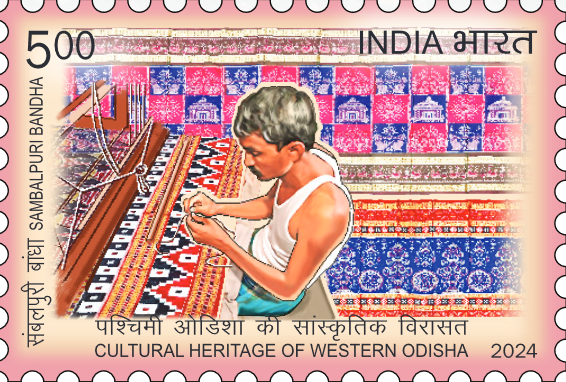Sambalpuri Bandha Silk Textile

Technical Data
| Stamp Set | Cultural Heritage of Western Odisha |
|---|---|
| Date of Issue | February 20, 2024 |
| Denomination | Rs. 5 |
| Quantity | 111,000 |
| Perforation | Harrow14½ |
| Printer | Security Printing Press, Hyderabad |
| Printing Process | Wet Offset |
| Watermark | No Watermark |
| Colors | Multicolor |
| Credit (Designed By) | Sh. Sankha Samanta |
| Catalog Codes |
Michel IN 3993 Colnect codes IN 2024.02.20-04c |
| Themes | Textile | Textile Industry |
Cultural Heritage of Western Odisha Stamp: A Tribute to Tradition
The Department of Posts has issued a special set of commemorative postage stamp honoring the cultural heritage of Western Odisha—a land where Aryan, Dravidian, and Adivasi traditions converge. These stamps capture the soul of Odisha, highlighting its festivals, art, crafts, and folk culture that continue to shape the identity of the region.
Sambalpuri Bandha : Weaving Stories into Threads
At the heart of Western Odisha’s culture lies the world-famous Sambalpuri Bandha (Ikat). This exquisite tie-dye weaving technique, practiced in districts such as Sambalpur, Balangir, Bargarh, Boudh, and Sonepur, creates fabrics where the warp and weft threads are dyed before weaving.
Traditional motifs like Sankha (conch-shell), Chakra (wheel), and Phula (flower) reflect Odia heritage and the sacred colors of red, black, and white, symbolic of Lord Jagannath.
The art of Bandhakala traces its origins to the migration of the Bhulia community in 1192 A.D. Over centuries, it evolved into the iconic Sambalpuri Ikat sarees, which gained global recognition in the 1980s and 1990s. Pioneers like Shri Radhashyam Meher, along with other master craftsmen, elevated the art form, ensuring its place in India’s textile legacy.
First Day Cover

